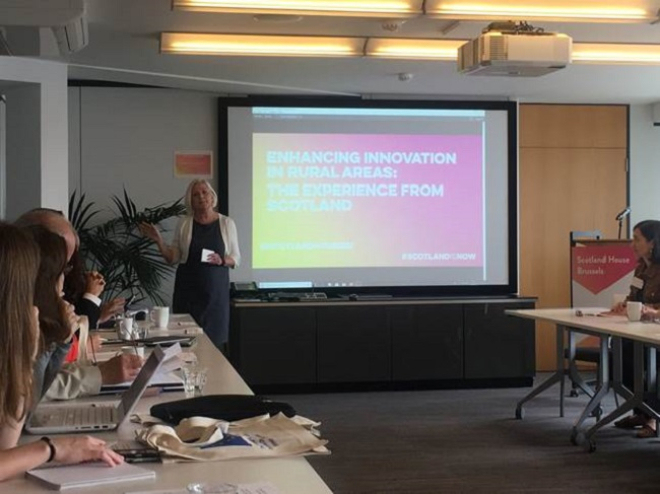Enhancing Innovation in Rural Areas: The Experience from Scotland

Following on from the 11th OECD Rural Development Conference in Edinburgh in April, Scotland House in Brussels went on to host the workshop ‘Enhancing Innovation in Rural Areas: The Experience from Scotland’ in Brussels this June.
The key aim of the event was to bring together policy makers with those involved in practical implementation of rural innovation projects. Speakers included research institutes, project participants and innovators from rural areas. The Scottish Government earlier this year launched the Rural Innovation Support Service (RISS), a Scottish Rural Development Programme initiative, to improve and further develop innovation across the rural economy in Scotland. In light of this, the main focus of the workshop was on examining the Scottish perspective on Rural Innovation developed over many years, and looking to the future with the recent launch of RISS. The workshop took place in the form of a round-table discussion, which consisted of EU-level and Scottish Stakeholders who have an interest in rural innovation and agriculture as well as general innovation policy.
Catriona Maclean, Head of Rural Economy and Communities of the Scottish Government, Jose Enrique Garcilazo of the OECD, and Fabio Cossu of the European Commission began the workshop by discussing the economic importance of innovation for rural areas. Innovation is seen as a key driver for rural areas to become more economically competitive, and the adoption of more digital practices is an opportunity for rural areas with decentralised production and workspaces. The OECD representative identified knowledge transfer and absorption as a big challenge for rural areas, which is why the OECD is focusing on the promotion of entrepreneurship, connecting local and global value chain and rural-urban interlinkages. The European Commission highlighted the work of the European Innovation Partnership for Agricultural Productivity and sustainability (EIP-AGRI) in building an EU innovation ecosystem.
Some examples of successful rural innovation projects were also presented during the workshop, including Anna Black of Scottish Enterprise’s Rural Leadership Programme. The SERLP is aimed at business managers and employees from rural businesses who have a desire to develop their leadership skills and grow their business. As one of the leaders trained by this programme, Anna Black presented her successful project of diversifying an average family farm into a destination of excellence for tourists and horse riders.
The SIMRA project, which examines social innovation in marginalised rural areas of Europe and beyond, is led by the James Hutton Institute. Professor Maria Nijnik, of the Institute’s Social, Economic and Geographical Sciences group, was invited to present the project during the event, as SIMRA seeks to bridge the gap between researchers and practitioners by advancing knowledge of rural innovation while supporting emerging innovation on the ground through its Innovation Actions and database of good practices. More than 300 examples are now part of this database, with no less than 10% of these very diverse examples located in Scotland, including community energy, social farming, rural services and others.
You can view or download the speaker’s presentations as well as the event programme below;
Innovation and EIP, Fabio Cossu
Innovation in Rural Areas, Enrique Garcilazo
Rural Innovation Supoort Service, David Mitchie
Social Innovation in Marginalised Rural Areas, Maria Nijnik
A Rural Leader's Perspective, Anna Black
Udny Community Trust and Wind Turbine, Garth Entwistle


